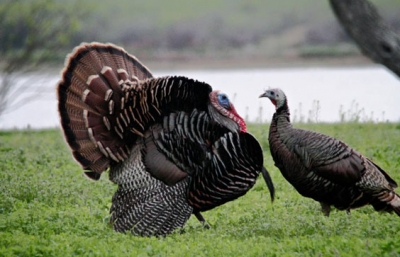
These large wild game birds come from the USA. Early European settlers almost wiped out the turkey in North America because it became one of their favourite foods.
Adult wild turkeys have long, reddish-yellow to grey-green legs, with feathers being blackish and dark, usually with a coppery sheen. Males have a large, featherless, reddish head and throat, with red wattles on the neck. The head also has fleshy growths called caruncles and a long, fleshy protrusion over the beak, which is called a snood.
When males become excited, the fleshy flap on the bill expands and the wattles and bare skin of the head and neck all become engorged with blood, almost concealing the eyes and bill. The tail becomes erect and fan-shaped, and the glossy bronze wings are drooped and held slightly out from the body, creating a very impressive sight.
Despite their huge size and weight, wild turkeys are not bad at flying and gliding, not only to get away from danger but also to go up to roost in trees. Their ideal habitat is open woodland or wooded pastures and scrub.
A wide range of noises are made by the male – especially in spring time. The well-known rapid ‘gobble’ noise can carry for up to a mile, to which hen birds will reply with a ‘yelp’, thereby letting the males know where they are located.
Nests are a simple, shallow dirt depressions amongst woody vegetation, in which the hen will lay a clutch of 10-14 eggs and incubate them for around 28 days. Once hatched, the chicks usually leave the nest within 12 hours, to follow along behind the hen.
Having once been an abundant bird, turkeys almost went extinct in the 1930s from loss of forest habitat and over hunting. However, recovery efforts were put in place and today the wild population is estimated to be 7 million in North and Central America.
Credit : Game and Wildlife Conversation Trust
Picture Credit : Google




